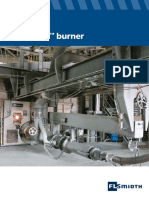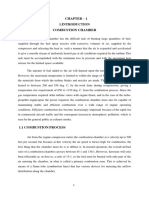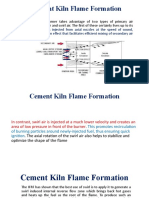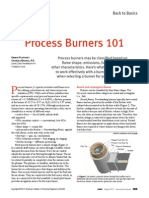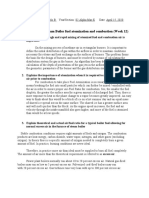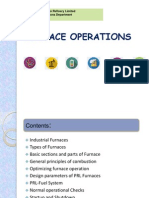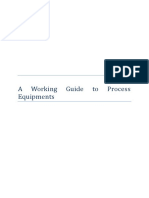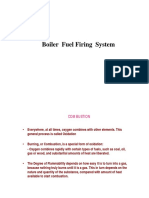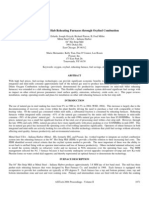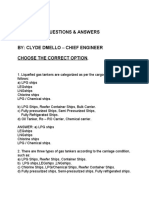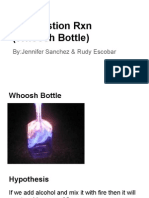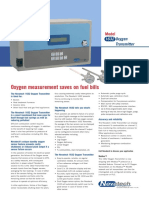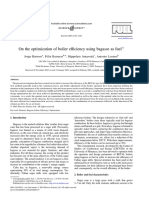Duo Flex
Duo Flex
Uploaded by
dwindra ramadhanCopyright:
Available Formats
Duo Flex
Duo Flex
Uploaded by
dwindra ramadhanCopyright
Available Formats
Share this document
Did you find this document useful?
Is this content inappropriate?
Copyright:
Available Formats
Duo Flex
Duo Flex
Uploaded by
dwindra ramadhanCopyright:
Available Formats
DUOFLEX burner
Flexible and robust design
Key benefits
- Robust design
- Low primary air consumption
- Adjustable swirl
- Adjustable air nozzle area
- Central fuel injection
Application
The DUOFLEX burner fires rotary
kilns with pulverised coal or coke, oil,
natural gas or any mixture of these
fuels. The burner may be fitted with
extra ducts for secondary fuels such as
plastic chips, wood chips, sewage
sludge, etc. Standard types are
available for any fuel combination and
a maximum capacity ranging from 20
to 250 MW, catering for even the
largest of rotary cement kilns.
Design
The burner is based on a novel concept
featuring a central duct for gaseous
and liquid fuels placed inside an
annular coal duct which is surrounded
by two concentric ducts that form two
primary air channels, one for radial air
and one for axial air.
The two air flows are mixed before
being injected via the conical air
nozzle. The two outer ducts form a very
rigid supporting structure, minimising
deflection of the burner pipe and
ensuring long refractory life.
The primary air is supplied by a high
pressure fan that yields a maximum
pressure of 250 mbar as standard,
but on request pressures up to 400
mbar can be delivered.
The air nozzle area can be adjusted
within the range 1:2. The axial/radial
air ratio and consequently the degree
of swirl is also adjustable.
These adjustments offer wide scope of
shaping the flame.
Process and function
From a process point of view, a burner
used for heating the burning zone of a
rotary cement kiln must fulfil the following requirements:
The burner must be able to fire coal,
coke, fuel oil and natural gas or any
mixture thereof, ensuring complete
combustion, low excess air and minimum formation of carbon monoxide
(CO) and nitrogen oxides (NOX).
If relevant, the burner must be able
to handle alternative fuels without
requiring change of its original
design. In this way, only minor
modifications to meet the special
requirements must be necessary.
The burner must produce a short,
narrow, strongly radiant flame, as
this is a condition for good heat
transfer from the flame to the material in the sintering zone of the kiln.
Flame formation must be conducive
to a dense, stable coating on the
refractory in the burning zone of
the kiln as well as a nodular clinker
with low dust content and correctly
developed clinker phases.
The burner must use as little primary
air as possible without compromising stability during normal or upset
operating conditions. Primary air is
basically false air, in other words air
that has not been used for clinker
heat recuperation while passing
through the clinker cooler. The
primary air is usually expressed as a
percentage of the stoichiometric
combustion air needed to burn
the amount of fuel fired through
the burner.
Multi-channel burners
Compared to a simple single-tube
burner modern multi-channel burners
offer much better possibilities for flame
shape control because of their separate
primary air channels, allowing for
adjustment of primary air amount and
injection velocity independently of the
coal meal injection.
The burner nozzle is
adjustable both vertical
and horizontally.
Nozzleopen
Nozzelclosed
The most important flame control
parameters are primary air momentum
(primary air amount multiplied by
discharge velocity) and amount of swirl
(tangentially air discharge). A high
momentum will give a short, hard
flame whereas a low momentum will
make the flame longer and lazier. Swirl
will help creating recirculation in the
central part of the flame. This will
stabilise the flame and give a short
ignition distance. Too much swirl
however can cause high kiln shell
temperatures due to flame impingement on the burning zone refractory.
A good swirl control system is therefore
important. The best solution would be
a system where swirl could be adjusted
independent of the momentum.
Traditional multi-channel burners
normally have two air nozzles, one
for axial air discharge and one with
vanes or tangential slots for swirl air.
Swirl is controlled by adjusting the
swirl air amount (or the ratio between
axial air and swirl air). This can be done
in two ways, by dampers installed in
the ducts upstream of the burner or
more effective - by adjusting the air
nozzle areas. Most modern multichannel burners therefore have
adjustable air nozzles.
If all the primary air is supplied by one
primary air fan, momentum and swirl
cannot be adjusted independently.
Adjusting the swirl air nozzle will also
change the pressure at the axial air
nozzle and vice versa. To overcome
this problem many multi-channel
burners have separate fans for axial
air and swirl air. This however does
not solve the problem completely
because the momentum will still
change if swirl air amount is changed.
A constant momentum can only be
maintained by adjusting axial air as
well as swirl air.
Duoflex Swirl Control
The unique Duoflex nozzle design
eliminates these problems. Swirl is
generated by fixed vanes, located
upstream of the air nozzle. Since axial
air and swirl air are mixed before
entering the nozzle, air pressure
and momentum remains almost
unchanged when the axial/swirl air
ratio is changed.
Axial/swirl air distribution is controlled
by butterfly valves installed at the
burner inlet. During operation the axial
air valve must be minimum 50% open
since the axial air is used for cooling
of the burner pipe. Swirl air can be
adjusted from 0-100%. The amount
of swirl is characterised by the position
only. Therefore no separate swirl airflow measuring system is necessary.
Since the swirler vanes are placed in a
low velocity zone the degree of swirl
will be reduced when the air velocity
is increased in the nozzle. The swirler
vane angle is dimensioned in order
to compensate for this, meaning
that an adequate amount of swirl
can be applied without risking flame
impingement on the refractory.
Flame momentum
The crucial parameter of flame formation is the primary air momentum
which may be expressed as the primary
air percentage (% of stoichiometric
air requirement) multiplied by the
injection velocity. Consequently, if the
velocity is doubled, the primary air
percentage may be reduced to half.
The primary air consumption will
normally be in the range of 6-8%,
corresponding to a primary air
momentum of approximately
1250-1780% m/s. The adjustable air
nozzle is ideally suited for adapting
the momentum to the conditions for
attaining the best flame shape.
The burner in a rotary kiln functions
as an injector, the purpose of which
is to draw the secondary air coming
from the cooler into the flame in
order to make the fuel burn as close
as possible to the centre line of the
kiln. This explains why the momentum
of the burner is the parameter that
determines flame formation. A higher
momentum means faster mixing and
a shorter and hotter flame.
Divergent feeding of fuel and primary
air should be avoided as it inevitably
leads to wider flames and higher
temperatures on the inner surface of
the burning zone. Good coating
formation is only possible if the inner
surface is cold enough for the liquid
to solidify upon contact.
The use of a narrow flame in a cement
rotary kiln is extremely important
since a divergent flame that impinges
upon the lining will strip off the
coating, resulting in very high kiln
shell temperature and short refractory
life. Flame impingement upon the
material charge will increase the
evaporation of sulphates, which
usually leads to increased coating
formation in the kiln riser duct.
Adjustable for
alternative fuels
In order to explore the economical opportunities on the waste market to the
maximum a high degree of freedom is
desired when adjusting the kiln feed
rates of various alternative fuel types.
On the other hand are the requirements that the heat input to the kiln
remains stable, that the firing of the fuels
does not have a negative impact on
the clinker quality and that the coating
profile in the kiln remains unchanged.
The combination of the quest for
optimum flexibility and the desire to
maintain steady kiln operation conditions puts high demands on the kiln
burner which - to the extent possible
- must be capable of compensating for
the variations of the alternative fuels
introduced into the kiln.
These demands are met by the superior
flame control of the DUOFLEX construction, and the ability of operating
with a narrow flame provides for the
best possible burnout of the waste
particles in the flame itself, so ensuring
that the particles do not land in the
charge or on the coating.
Precise momentum control
Since good flame formation in the kiln
permits operating with very little excess
air and without the formation of CO,
a burner operating with correct flame
momentum despite the higher flame
temperature will result in less formation
of NO than a low momentum burner
operating with more excess air.
Practical experience has shown that
the formation of a strong, stable, short
and narrow flame requires a momentum of minimum 1400-1600% m/s
dependent on fuel type. A flame
momentum below this range will result
in too long a flame, high kiln shell
temperatures above the burning zone
and in the kiln back end as well as
unstable kiln operation with a too long
and cold burning zone thereby permitting undesirable clinker crystal growth.
The two different kiln temperature
profiles, before and after introducing
the DUOFLEX burner, clearly show the
huge effect on both coating formation
and kiln shell temperature. NO lining
repairs were made while exchanging
the two burner installations.
The very easy adjustment of the nozzle
area and the different air flows,
helped by clear position indicators,
make it possible to find and maintain
any precise setting during operation
as well as between the different
production campaigns.
The DUOFLEX burner normally
operates with 6-8 % primary air but
is designed for maximum 10% as
standard and on request up to 15%.
This will in all cases provide the kiln
operator with the necessary tool to
quickly stabilise any upset conditions.
Momentum control, example
Calciner kiln:
Burner output:
Max. momentum:
Momentum required:
7000 tpd
118 MW
8.7 N/MW (at 12.5% PA)
5 N/MW
1. Reducing nozzle area:
Air flow:
8195 m3/h (6.9% PA)
Air pressure:
278 mbar
Power consumption:
80 kW
2. Reducing nozzle pressure:
Air flow:
11120 m3/h (9.3% PA)
Air pressure:
140 mbar
Power consumption:
102 kW
Savings by reducing nozzle area instead of pressure:
Power:
22 kW
Fuel: 2.4% PA y 2.4x0.75 = 1.8 kcal/kg clinker y 12.6 Mcal/24H
Primary air fan
300
1. Reduced nozzle area
Reduced momentum
5 N/MW
278 mbar
8195 m3/h
Max. nozzle area
250
Max. momentum
8.7 N/MW
254 mbar
14911 m3/h
mbar, kW
200
150
2. Max. nozzle area
Reduced momentum
5 N/MW
140 mbar
11120 m3/h
100
Increased power consumption
y 22 kW
50
Increased air flow
y 2900 m3/h
2,5
7,5
10
12,5
Flow 1000 m3/h
15
17,5
20
22,5
DuoFlex
Traditional burner
Kiln shell temperature
MAX/MIN
DUOFLEX
Traditional burner
400
300
200
100
0
10
20
30
40
50
60
70
Copyright 2013 FLSmidth A/S. ALL RIGHTS RESERVED. FLSmidth is a (registered) trademark of FLSmidth A/S. This brochure makes no offers, representations
or warranties (express or implied), and information and data contained in this brochure are for general reference only and may change at any time.
Project Centre Denmark
FLSmidth A/S
Vigerslev All 77
DK-2500 Valby
Copenhagen
Tel: +45 3618 1000
Fax: +45 3630 1820
E-mail: info@flsmidth.com
Project Centre USA
FLSmidth Inc.
2040 Avenue C
Bethlehem, PA 18017-2188
Tel: +1 610-264-6011
Fax: +1 610-264-6170
E-mail: info-us@flsmidth.com
Project Centre India
FLSmidth Private Limited
FLSmidth House
34, Egatoor, Kelambakkam
(Rajiv Gandhi Salai, Chennai)
Tamil Nadu 603 103
Tel: +91-44-4748 1000
Fax: +91-44-2747 0301
E-mail: indiainfo@flsmidth.com
www.flsmidth.com
C 03-13 400-26-ENG
Metres
You might also like
- Duo FlexDocument8 pagesDuo FlexIsaac Martínez AlcocerNo ratings yet
- Duoflex PDFDocument8 pagesDuoflex PDFTinTunNaingNo ratings yet
- Duoflex Burner PDFDocument6 pagesDuoflex Burner PDFIndra D. Winarko100% (1)
- Combustion Chamber ProjectDocument42 pagesCombustion Chamber Project26 MaheshkannanNo ratings yet
- Duoflex BurnerDocument6 pagesDuoflex Burnersinghite100% (1)
- GTE Combustion ChamberDocument33 pagesGTE Combustion ChamberTAMILSELVAM NALLUSAMYNo ratings yet
- Eit-M: Thermal Power PlantDocument13 pagesEit-M: Thermal Power PlanthayelomNo ratings yet
- 15.5 Combustion SectionDocument14 pages15.5 Combustion SectionArun RajeevNo ratings yet
- Importance of Air Distribution Between BurnersDocument2 pagesImportance of Air Distribution Between BurnersKamal Arab100% (1)
- Burners: Air-Steam Atomizing Oil BurnersDocument8 pagesBurners: Air-Steam Atomizing Oil BurnersAhmed GadNo ratings yet
- Cement Kiln Flame FormationDocument7 pagesCement Kiln Flame Formationengr kazamNo ratings yet
- Boiler BurnersDocument8 pagesBoiler BurnersAnoop VijayakumarNo ratings yet
- Selection of FiredDocument5 pagesSelection of Firedahmed hossamNo ratings yet
- Flare Types and ComponentsDocument6 pagesFlare Types and Componentskinjalpatel12345No ratings yet
- Boiler Design AspectsDocument43 pagesBoiler Design AspectsAashish PalNo ratings yet
- Polflame 1613 enDocument3 pagesPolflame 1613 enAnonymous Cxriyx9HIXNo ratings yet
- Boiler NotesDocument34 pagesBoiler NotesRakesh Singh BhadoriyaNo ratings yet
- Burner FurnaceDocument5 pagesBurner FurnaceShaikh Muhammad UsamaNo ratings yet
- Gun Burner. Materi 1Document10 pagesGun Burner. Materi 1DwiIndraswari100% (1)
- Module 5 CombustorDocument11 pagesModule 5 CombustorKevin MangroliyaNo ratings yet
- Specify Better Low NOx Burners For FurnacesDocument4 pagesSpecify Better Low NOx Burners For Furnacesyogitadoda100% (1)
- CHE Facts - Industrial Gas Burners - July 2016Document1 pageCHE Facts - Industrial Gas Burners - July 2016John UrdanetaNo ratings yet
- Module 5 Aircraft Propulsion NotesDocument48 pagesModule 5 Aircraft Propulsion NotesPratham M JariwalaNo ratings yet
- Design of Gas Turbine Combustion ChamberDocument11 pagesDesign of Gas Turbine Combustion ChamberSai Rahul100% (1)
- Research Work Week 12Document4 pagesResearch Work Week 12jonas lintagNo ratings yet
- Fine Tuning A CFBC Boiler PDFDocument12 pagesFine Tuning A CFBC Boiler PDFrikumohanNo ratings yet
- Furnace OperationsDocument53 pagesFurnace OperationsRana Shahid Raza100% (3)
- Retrofitting The Existing Flare / Burnery For Smoke Less OperationsDocument31 pagesRetrofitting The Existing Flare / Burnery For Smoke Less Operationsmehul10941No ratings yet
- Combustion ChamberDocument3 pagesCombustion ChamberShreyash ChandakNo ratings yet
- Combustion Chamber Design and Modern DevelopmentDocument7 pagesCombustion Chamber Design and Modern DevelopmentNidushan NethsaraNo ratings yet
- 1386 - C11 Burner Design PDFDocument32 pages1386 - C11 Burner Design PDFMartin Martin MartinNo ratings yet
- A Working Guide To Process Equipments Upto 22062016Document37 pagesA Working Guide To Process Equipments Upto 22062016DPKRSTGINo ratings yet
- Boiler Case StudyDocument17 pagesBoiler Case StudyAbu Faiz100% (1)
- CFBC BoilersDocument11 pagesCFBC BoilersManoj DesaiNo ratings yet
- Industrial BurnersDocument23 pagesIndustrial Burnerskarthikeyan5000No ratings yet
- Beant College of Engineering and Technology Gurdaspur: Seminar Report (TH-590)Document20 pagesBeant College of Engineering and Technology Gurdaspur: Seminar Report (TH-590)Ahmad Riaz KhanNo ratings yet
- Combustion SectionDocument26 pagesCombustion SectionNicole Deione Morcilla100% (1)
- BurnerDocument4 pagesBurnerAhmed Mohamed KhalilNo ratings yet
- Combustion TuningDocument9 pagesCombustion TuningRamakrishnan NatarajanNo ratings yet
- Combustion Chamber DesignDocument19 pagesCombustion Chamber DesignPRAVEEN100% (1)
- 04 - FFS - TRG - SC2 PDFDocument65 pages04 - FFS - TRG - SC2 PDFLakshmi NarayanNo ratings yet
- Prepared By: Hemanthkrishnan R Roll No 44 S5Ma NssceDocument22 pagesPrepared By: Hemanthkrishnan R Roll No 44 S5Ma NssceKing100% (1)
- Economizer, Furnace, Burner, Air Fuel RatioDocument11 pagesEconomizer, Furnace, Burner, Air Fuel RatioPriyaNo ratings yet
- CFBC Boiler DescriptionDocument9 pagesCFBC Boiler Descriptioncmani_bweNo ratings yet
- Super HeaterDocument5 pagesSuper HeaterSurya VankayalaNo ratings yet
- Air Register, Types of Burner and Overhauling of BurnerDocument4 pagesAir Register, Types of Burner and Overhauling of BurnerSid ACHARYANo ratings yet
- Advantages of Ultra Super - FINALDocument6 pagesAdvantages of Ultra Super - FINALAmar N. MauryaNo ratings yet
- Sunflower: Husks BoilersDocument8 pagesSunflower: Husks BoilersalfredopinillosNo ratings yet
- Fuel Savings For Slab Reheating Furnaces Through Oxyfuel CombustionDocument6 pagesFuel Savings For Slab Reheating Furnaces Through Oxyfuel CombustionДимитър СлавовNo ratings yet
- A Study On Boiler Efficiency Improvement by Controlling Flue Gas Heat LossesDocument9 pagesA Study On Boiler Efficiency Improvement by Controlling Flue Gas Heat Lossespriyajit sahooNo ratings yet
- Boiler Heat Transfer Theory-02Document18 pagesBoiler Heat Transfer Theory-02Sai SwaroopNo ratings yet
- 04 Combustion ChamberDocument6 pages04 Combustion ChamberprasannabalajiNo ratings yet
- Gas Turbine Combustion Chamber Design Aspects & Current TrendsDocument24 pagesGas Turbine Combustion Chamber Design Aspects & Current TrendsPRAVEENNo ratings yet
- Combustion Tuning in High Ash Pulverized Coal Fired Boilers Having Direct Tangential Firing SysteDocument2 pagesCombustion Tuning in High Ash Pulverized Coal Fired Boilers Having Direct Tangential Firing SysteraghuveeranushNo ratings yet
- 3 Gas and Oil FuelsDocument20 pages3 Gas and Oil FuelsCristhian Garcia VillarroelNo ratings yet
- Design Optimization of Can Type Combustor: T J Prasanna Kumar, S Koteswara Rao, S Durga Prasad, MD Faisal, P AnilDocument8 pagesDesign Optimization of Can Type Combustor: T J Prasanna Kumar, S Koteswara Rao, S Durga Prasad, MD Faisal, P AnilSakuNo ratings yet
- Chimneys & Fireplaces: They Contribute to the Health Comfort and Happiness of the Farm Family - How to Build ThemFrom EverandChimneys & Fireplaces: They Contribute to the Health Comfort and Happiness of the Farm Family - How to Build ThemNo ratings yet
- Encyclopaedia Britannica, 11th Edition, Volume 8, Slice 3 "Destructors" to "Diameter"From EverandEncyclopaedia Britannica, 11th Edition, Volume 8, Slice 3 "Destructors" to "Diameter"No ratings yet
- Briquette Production Manual: Basic and Advanced TechnologyDocument36 pagesBriquette Production Manual: Basic and Advanced Technologymohammed100% (1)
- 56 SEIAA Meeting (3.10.2012) PDFDocument91 pages56 SEIAA Meeting (3.10.2012) PDFBhaskar ShanmugamNo ratings yet
- Natural Resources and Environment Ordinance, 1993 - Chapter 84, Law of Sarawak 1958Document36 pagesNatural Resources and Environment Ordinance, 1993 - Chapter 84, Law of Sarawak 1958cksNo ratings yet
- Noc19 Me10 Assignment5Document4 pagesNoc19 Me10 Assignment5averify53No ratings yet
- Data SheetDocument8 pagesData SheetMohamed DarwishNo ratings yet
- Jasmine Essential Oil MSDSDocument5 pagesJasmine Essential Oil MSDSSri RengaNo ratings yet
- Narrative Report On The Conduct of Fire Safety DrillDocument10 pagesNarrative Report On The Conduct of Fire Safety DrillMariel Maitim Millera100% (1)
- Medimum Size Gas Boiler (Service Manual) - enDocument69 pagesMedimum Size Gas Boiler (Service Manual) - enleandro_hwashinNo ratings yet
- Compre Special Project (PPE &IPE)Document240 pagesCompre Special Project (PPE &IPE)Allen Espeleta81% (48)
- Oxygen Bomb CalorimeterDocument16 pagesOxygen Bomb CalorimeterJerico LlovidoNo ratings yet
- Btlgtco Multiple Choice Questions & AnswersDocument25 pagesBtlgtco Multiple Choice Questions & AnswersKennen LasradoNo ratings yet
- Book 1 System 2016Document155 pagesBook 1 System 2016annis99No ratings yet
- ChemistryDocument10 pagesChemistryapi-275510930No ratings yet
- L3 Energy Balance Reactive SystemDocument16 pagesL3 Energy Balance Reactive Systemchiang95No ratings yet
- Air Quality: Best Practice GuideDocument44 pagesAir Quality: Best Practice GuideAmjid AliNo ratings yet
- TPP Steel PlantDocument25 pagesTPP Steel PlantPRASANTHNo ratings yet
- Hazardous Substances PlanDocument4 pagesHazardous Substances Planفواد جانNo ratings yet
- Job Interview Questions & Answers - Mechanical EngineeringDocument8 pagesJob Interview Questions & Answers - Mechanical EngineeringSandeepRajNo ratings yet
- Inline Injection PumpDocument93 pagesInline Injection PumpElias Girma100% (3)
- Phast 6 7 Release NotesDocument32 pagesPhast 6 7 Release Noteskumaravel158100% (1)
- Curriculum For B.sc. in AEDocument82 pagesCurriculum For B.sc. in AERayhanul KarimNo ratings yet
- Eryclone Anti A MSDSDocument4 pagesEryclone Anti A MSDSAndre WijayaNo ratings yet
- 1632 Oxygen Transmitter - Data SheetDocument2 pages1632 Oxygen Transmitter - Data SheetRaymund GatocNo ratings yet
- Ws 2016 13-Pdf-EnDocument2 pagesWs 2016 13-Pdf-EnMuhammadUsmanSaeedNo ratings yet
- Deign Method D HRDDocument7 pagesDeign Method D HRDmatiyasNo ratings yet
- Optimization of Bagasse Fired Boilers PDFDocument13 pagesOptimization of Bagasse Fired Boilers PDFGd AlexNo ratings yet
- 2 Stroke and 4 Stroke Difference Basic For Junior Marine Engineers-Rammarsea - BASIC MARINE DIESEL ENGINESDocument6 pages2 Stroke and 4 Stroke Difference Basic For Junior Marine Engineers-Rammarsea - BASIC MARINE DIESEL ENGINESmanjuNo ratings yet
- 2118-2517-Methylphenidate 27 MG Atras (2de2)Document349 pages2118-2517-Methylphenidate 27 MG Atras (2de2)Josue Ivan Buendia GarciaNo ratings yet
- Bond Enthalpies 1 QPDocument8 pagesBond Enthalpies 1 QPRabia RafiqueNo ratings yet
- ATEX Non ElectricalDocument10 pagesATEX Non ElectricalmigelNo ratings yet

